Mối quan hệ giữa hấp dẫn thương hiệu nhà tuyển dụng và hiệu suất công việc của nhân viên: Nghiên cứu các doanh nghiệp ngành dịch vụ tại thành phố Hồ Chí Minh
Bài viết này nghiên cứu mối quan hệ giữa hấp dẫn thương hiệu nhà tuyển dụng (Employer Brand
Attractiveness - EBA) và hiệu suất công việc của nhân viên. Mẫu nghiên cứu gồm 412 nhân viên đang làm
việc ở các doanh nghiệp ngành dịch vụ tại Tp.HCM, khảo sát bằng bảng câu hỏi từ tháng 8/2019 đến tháng
01/2020. Từ dữ liệu thu thập, tiến hành xử lý, phân tích Cronbach's Alpha, EFA, CFA, SEM và kiểm định
các giả thuyết của mô hình. Kết quả nghiên cứu cho thấy những thành phần giá trị của EBA được đo lường
bằng giá trị kinh tế, giá trị phát triển, giá trị xã hội, giá trị thích thú và giá trị ứng dụng. Kết quả cũng cho
thấy các thành phần của EBA có tác động cùng chiều đến hiệu suất công việc của nhân viên. Tuy nhiên, giá
trị kinh tế của EBA tác động rất thấp đến hiệu suất. EBA là một chiến lược dài hạn, với mục tiêu để quản
lý nâng cao thái độ và hành vi của nhân viên, chiến lược này có thể được điều chỉnh để thúc đẩy các nỗ lực
trong quá trình quản lý nguồn lực của tổ chức.

Trang 1
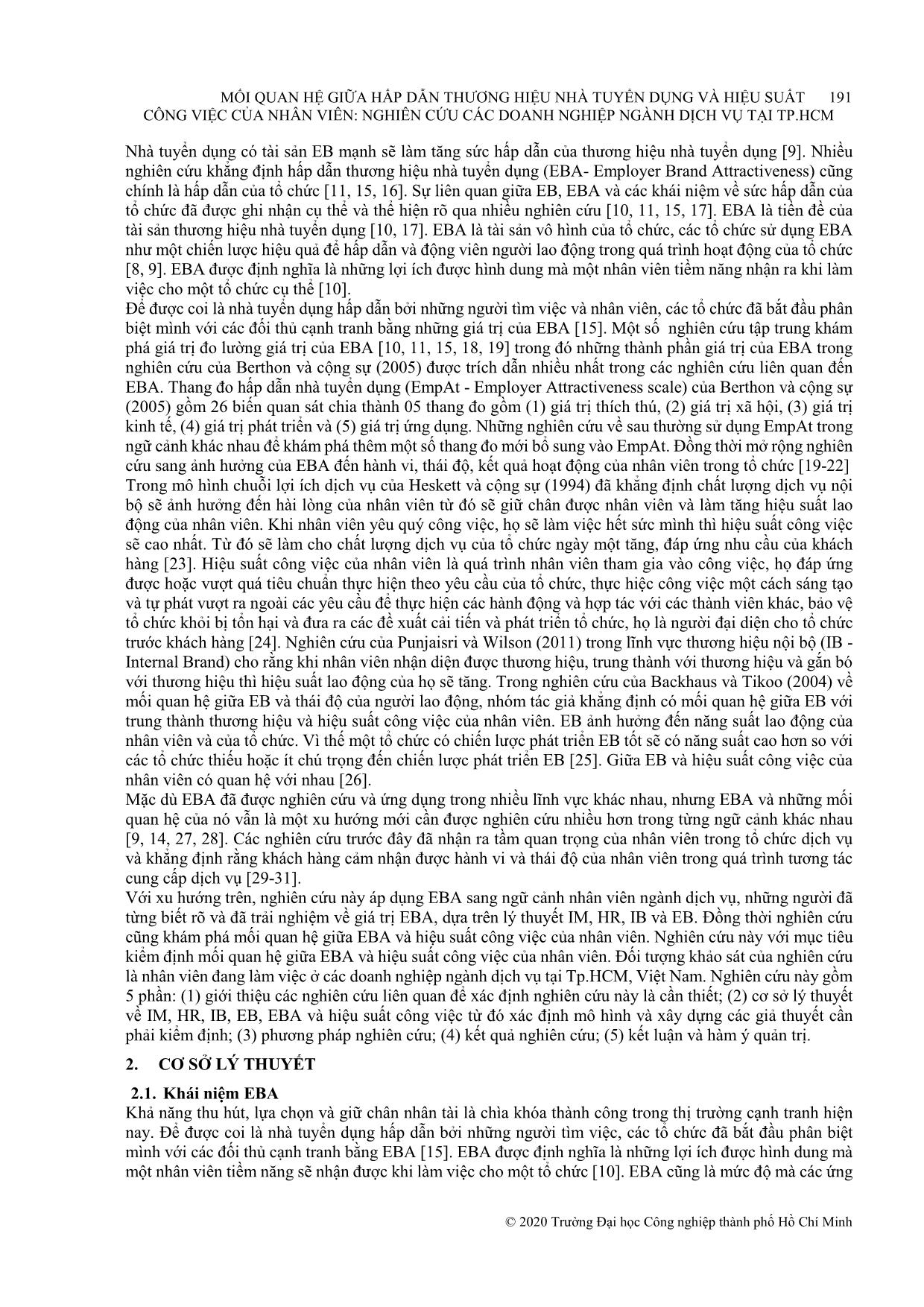
Trang 2
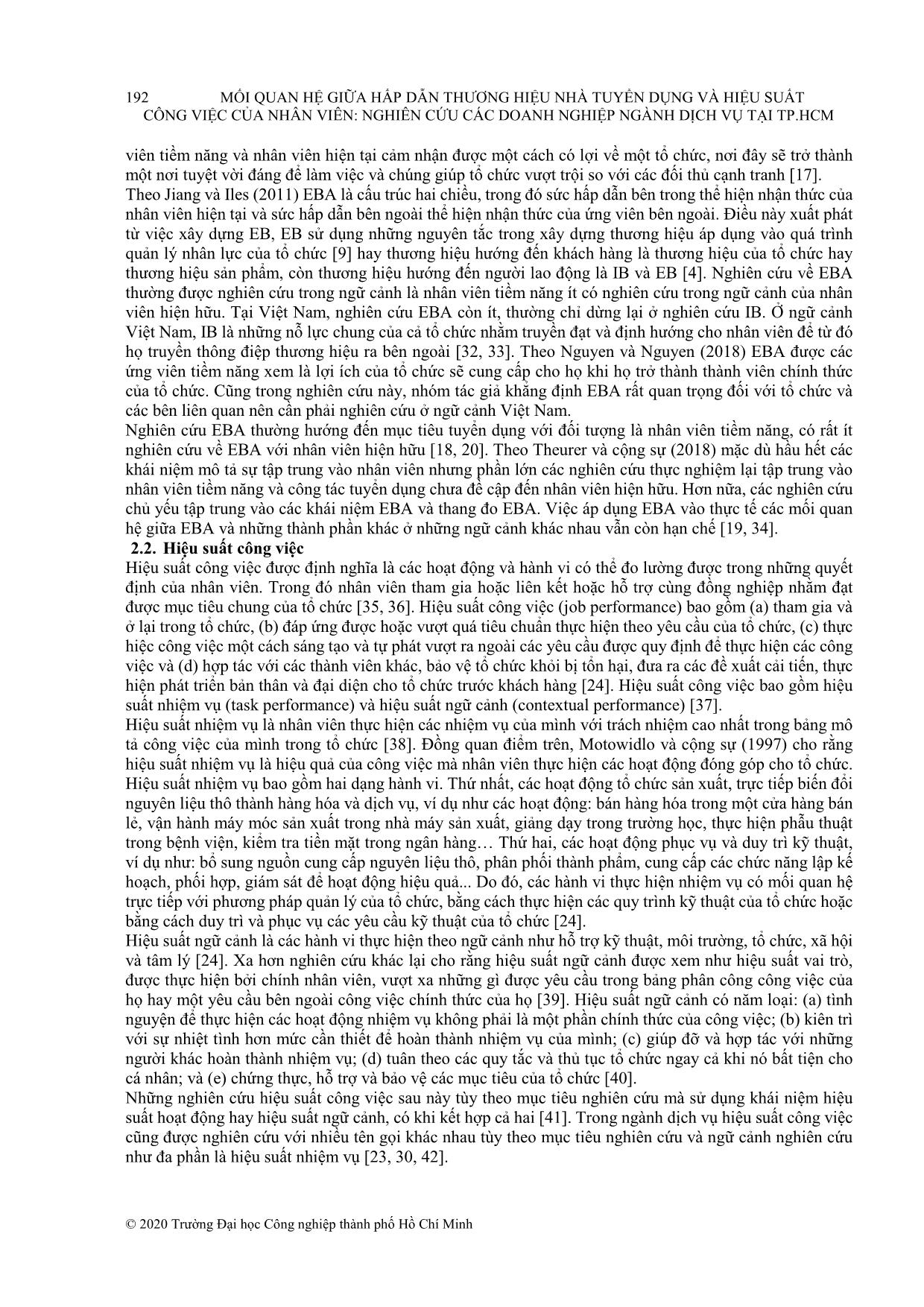
Trang 3
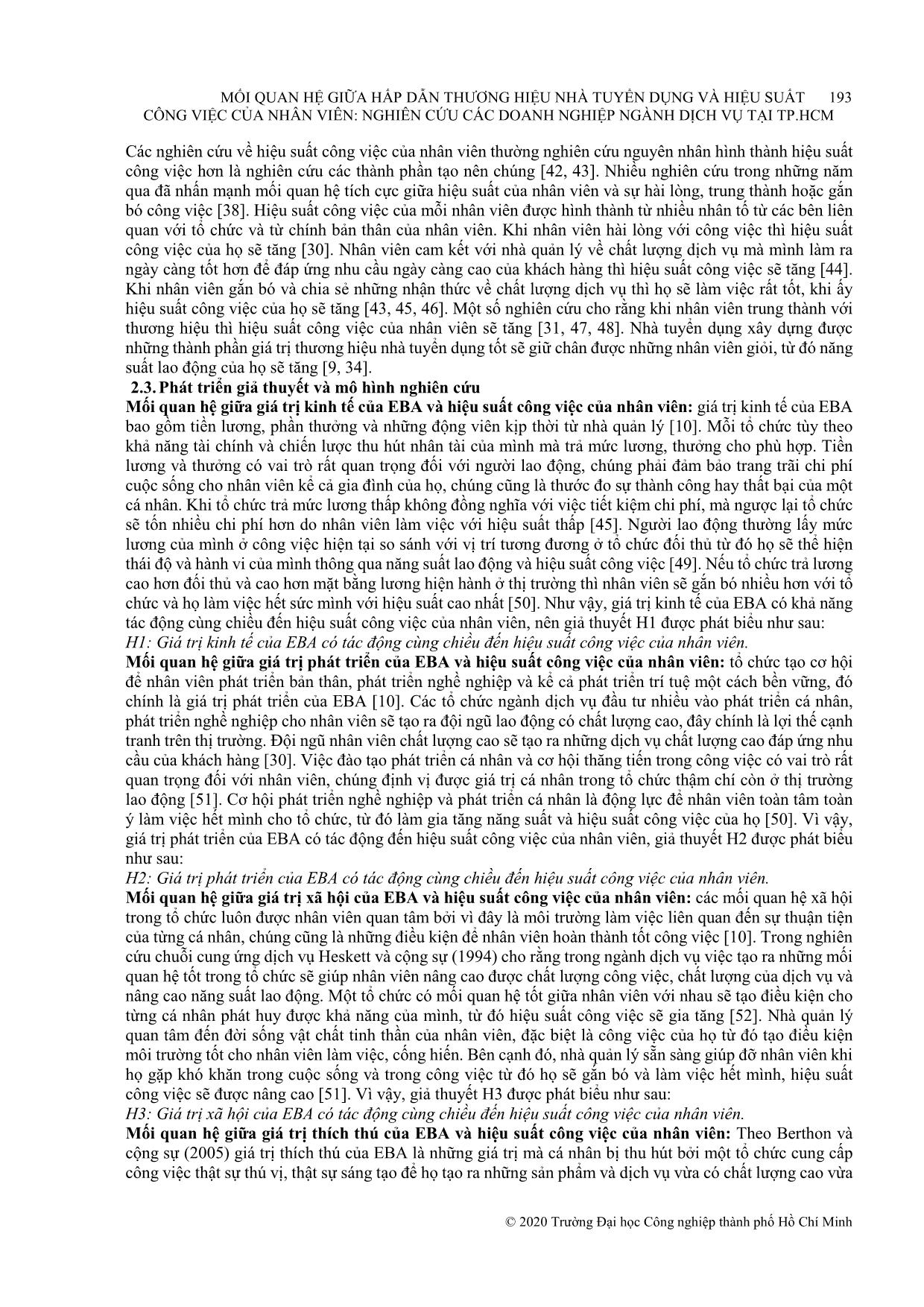
Trang 4
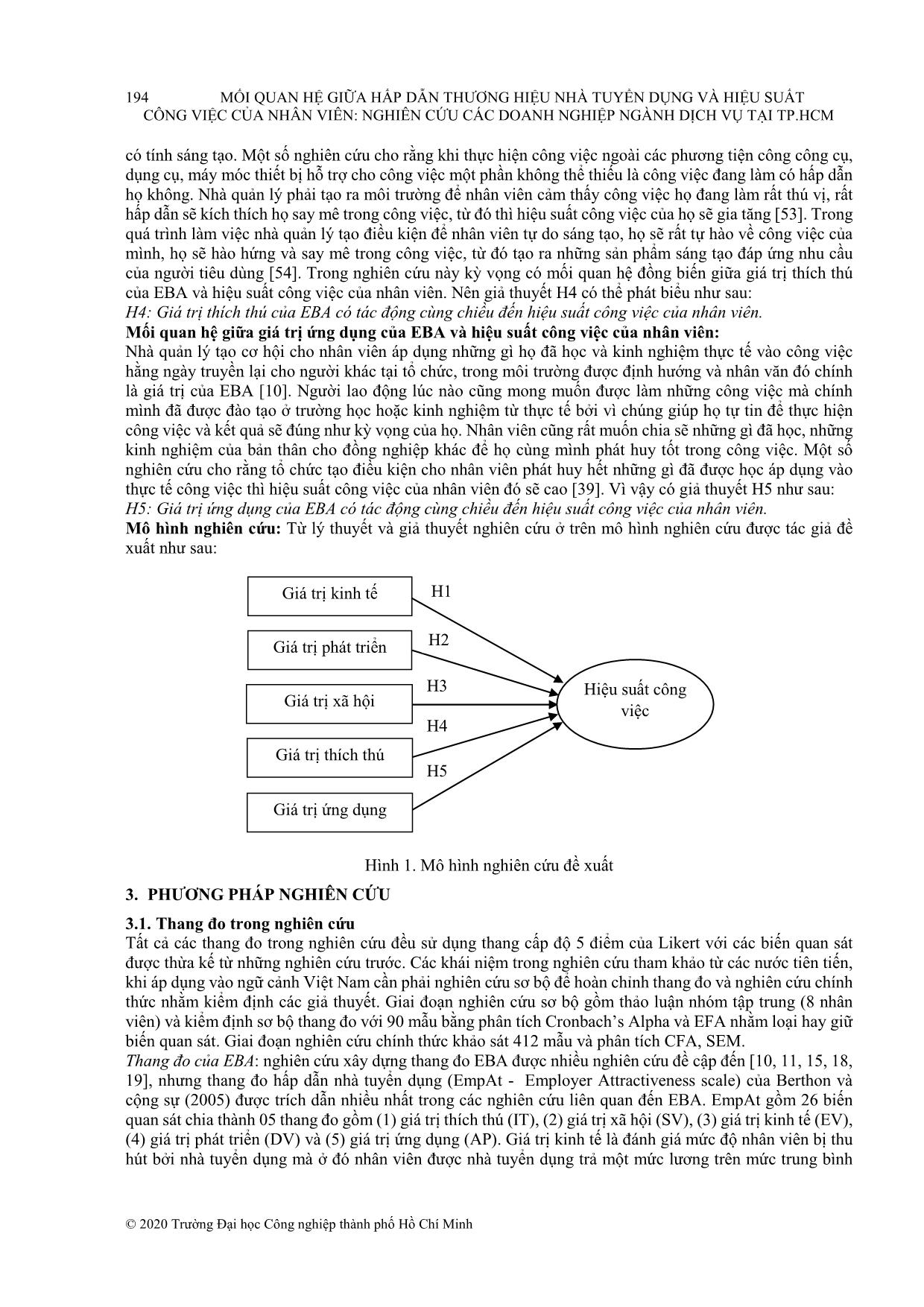
Trang 5
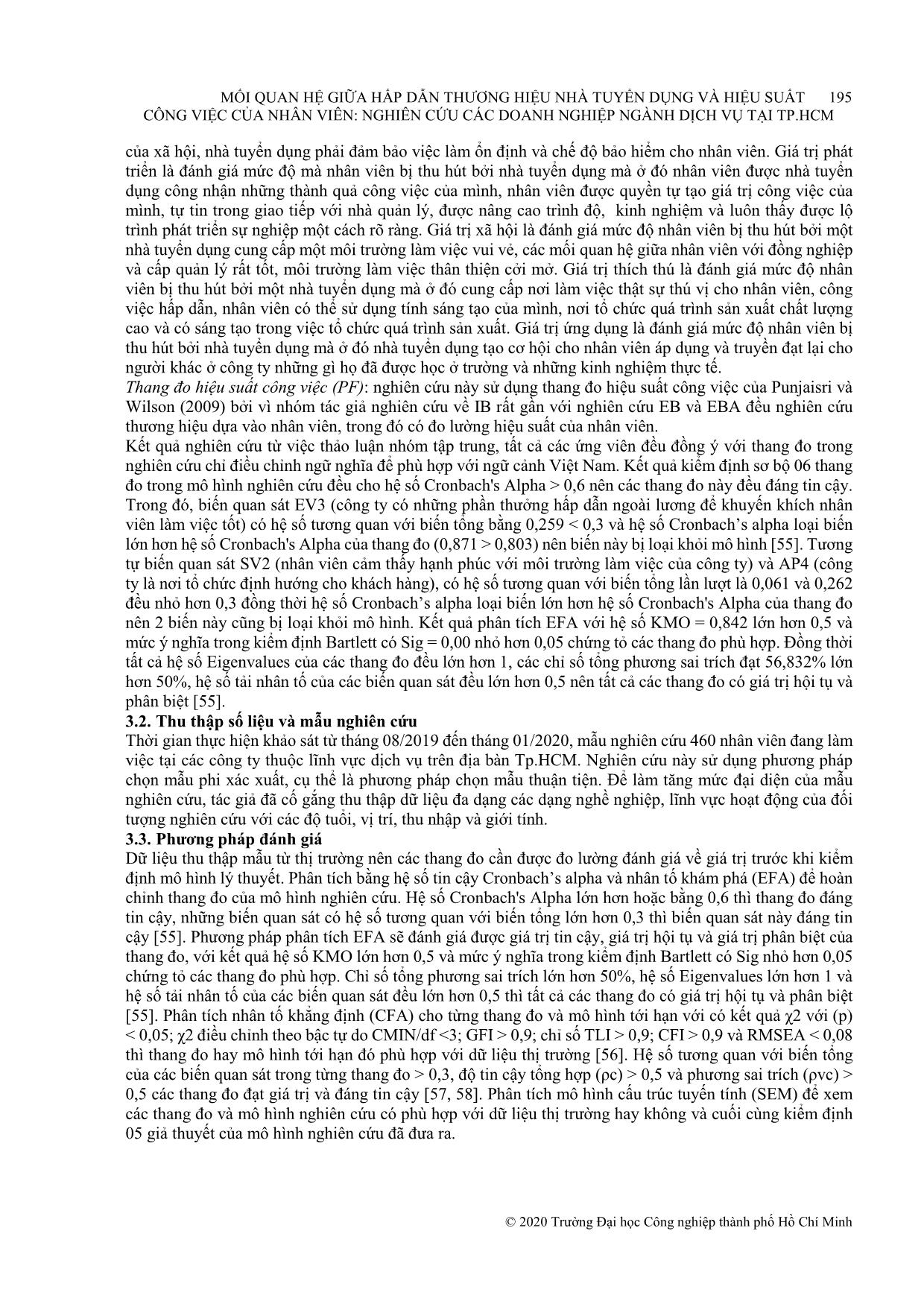
Trang 6
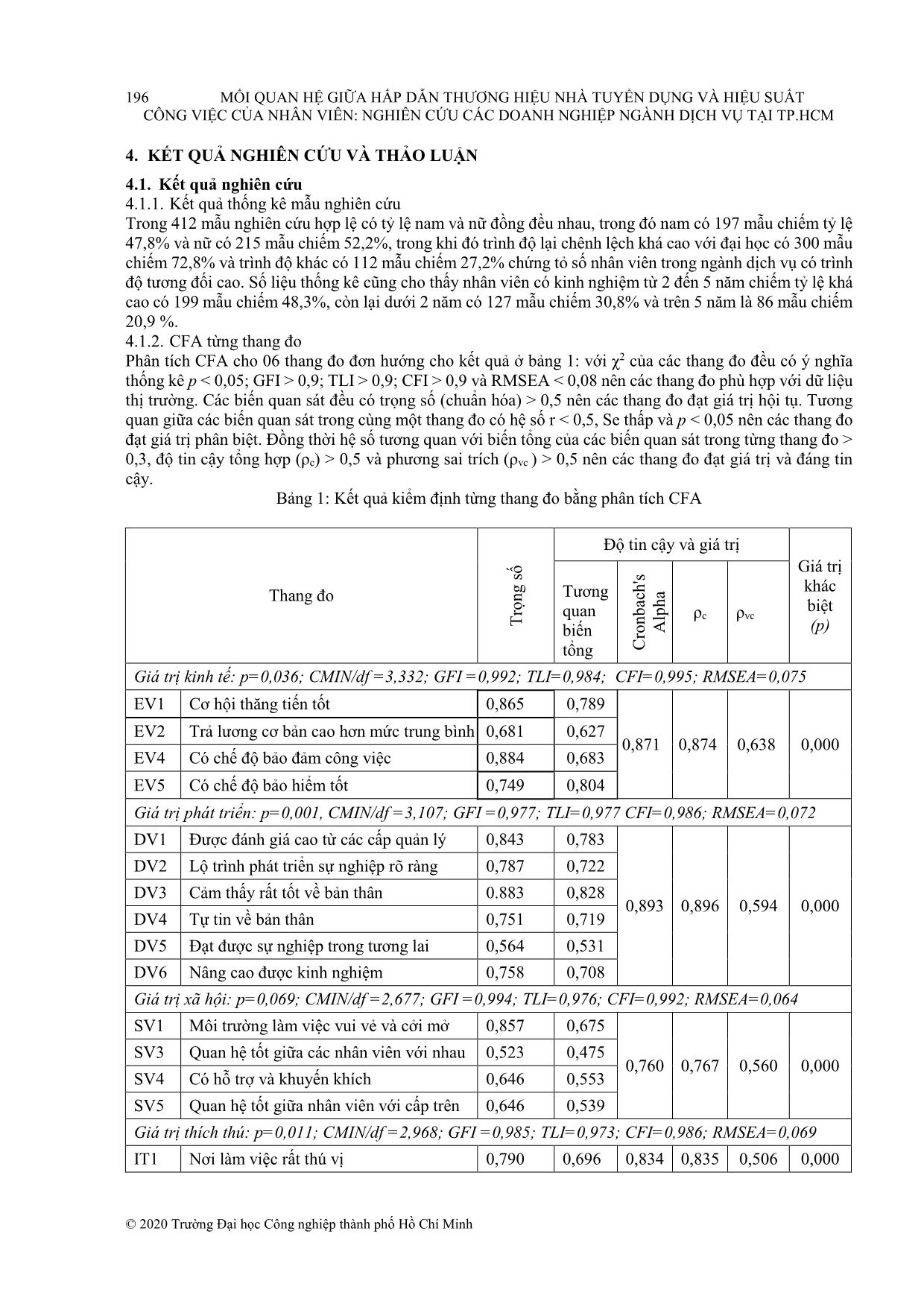
Trang 7
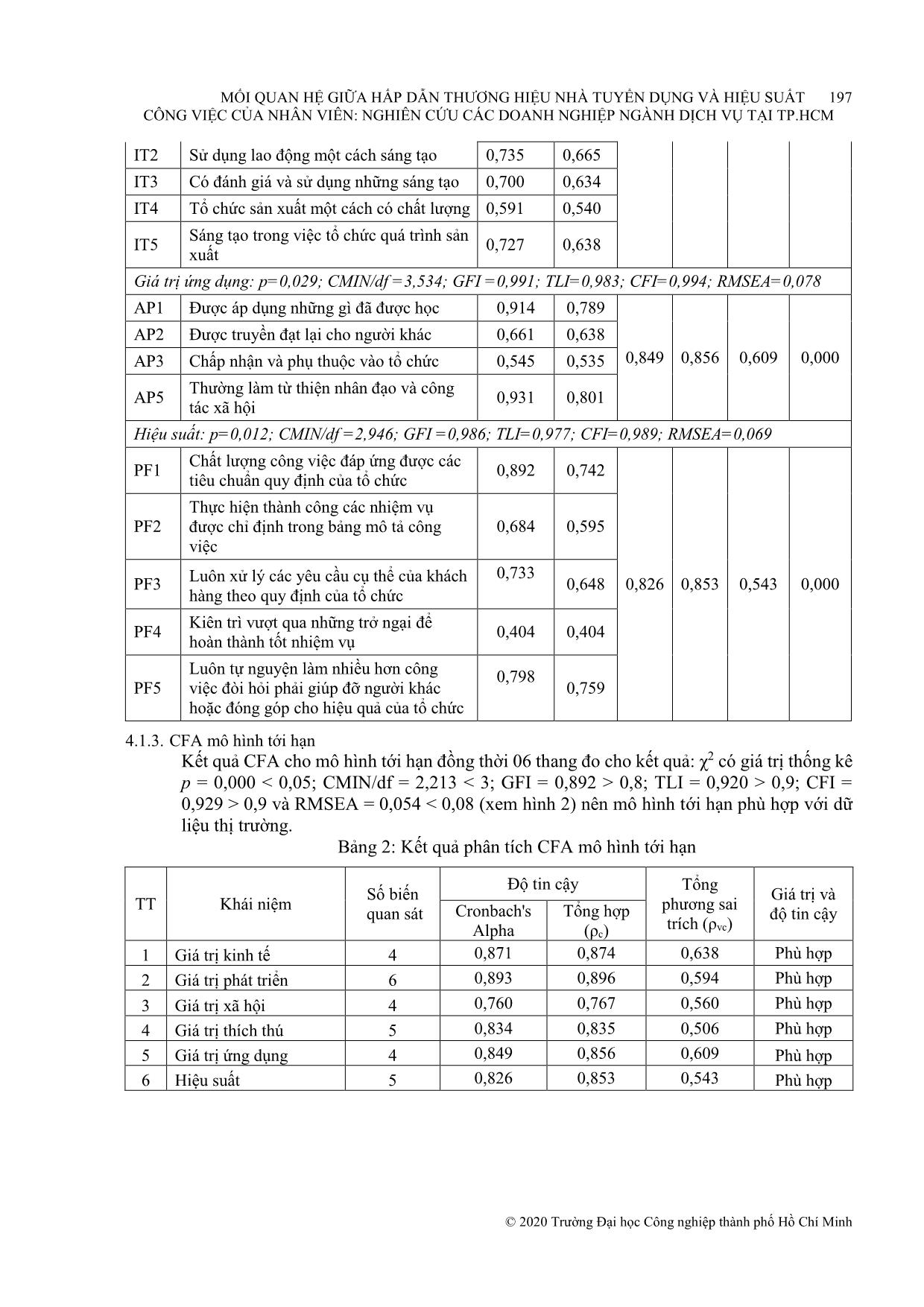
Trang 8
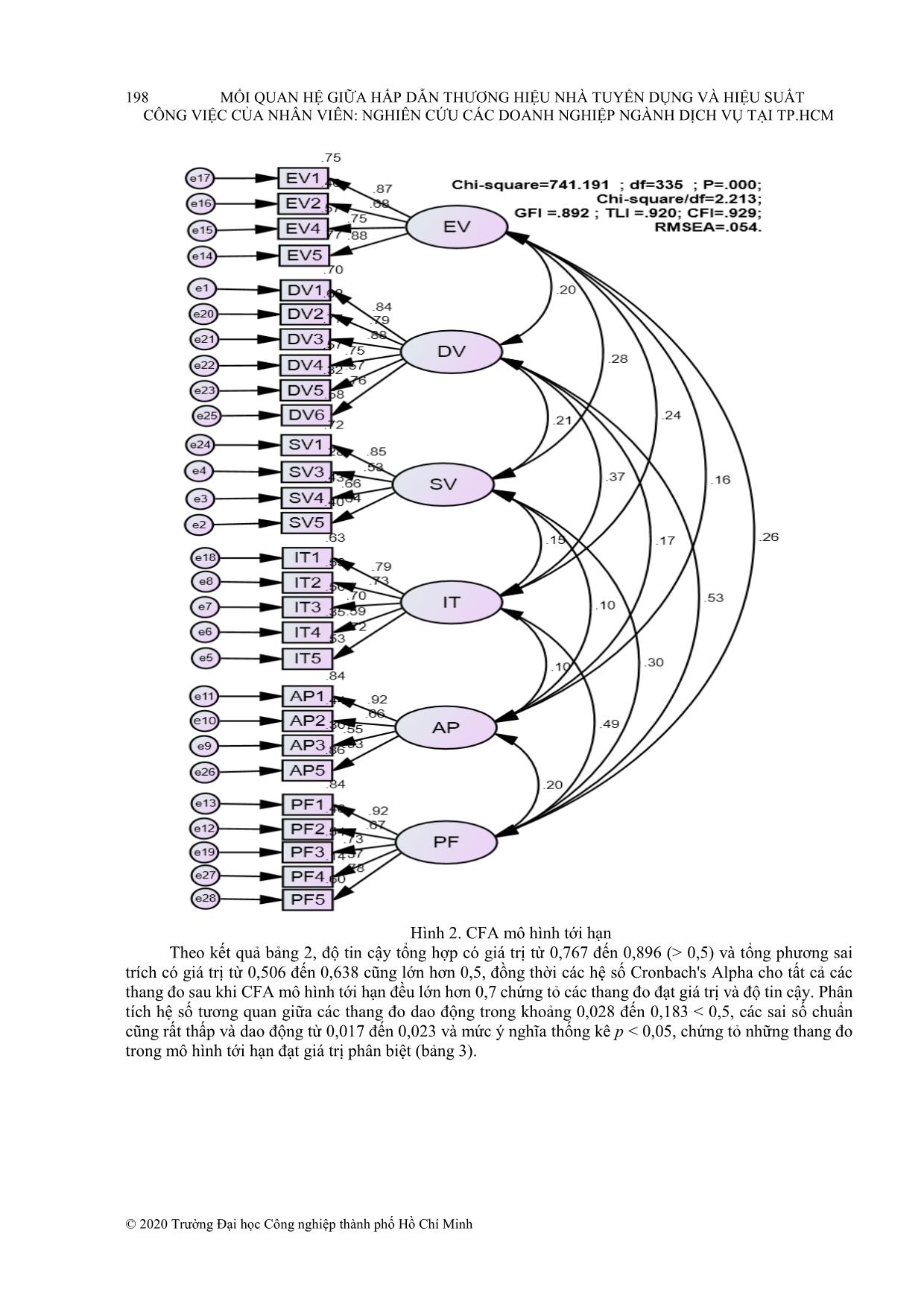
Trang 9
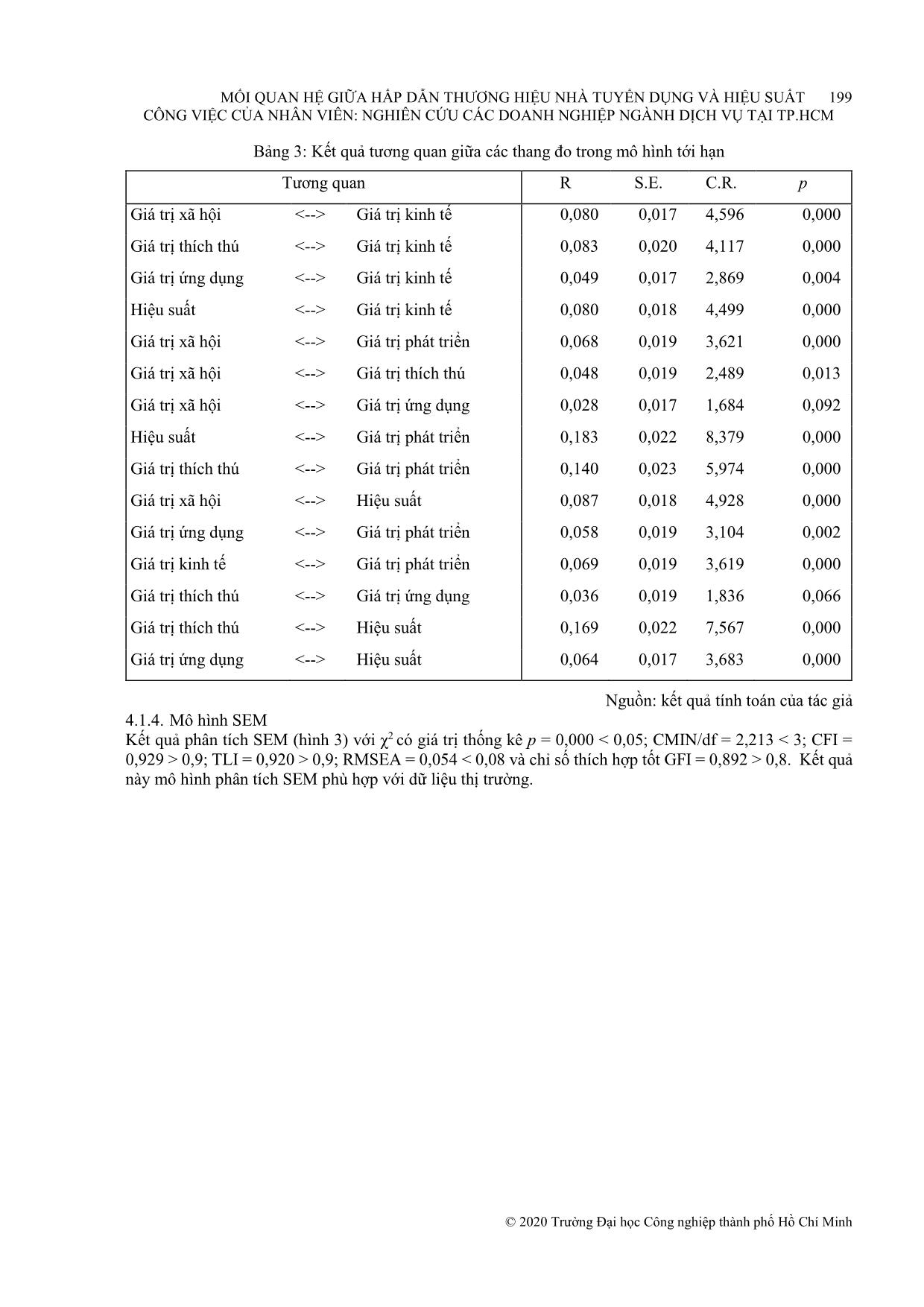
Trang 10
Tải về để xem bản đầy đủ
Tóm tắt nội dung tài liệu: Mối quan hệ giữa hấp dẫn thương hiệu nhà tuyển dụng và hiệu suất công việc của nhân viên: Nghiên cứu các doanh nghiệp ngành dịch vụ tại thành phố Hồ Chí Minh
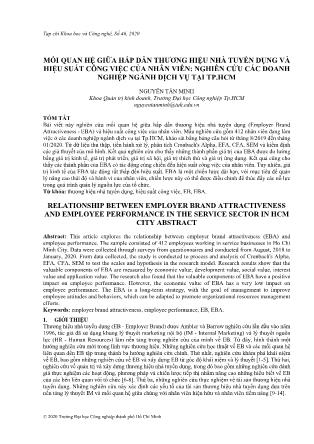
y giúp nhà quản trị các doanh nghiệp dịch vụ thấy được sự tác động rất mạnh những thành phần giá trị của EBA đến hiệu suất công việc của nhân viên. Từ đó, nhà quản trị sẽ sử dụng những giá trị của EBA này nhằm tăng hiệu suất công việc của nhân viên: Thứ nhất, giá trị phát triển có hệ số β chuẩn hóa cao nhất (0,402) chứng tỏ chúng tác động mạnh nhất đến hiệu suất công việc của nhân viên. Vì vậy, trong quá trình hoạt động nhà quản trị nên quan tâm đến giá trị phát triển cá nhân của nhân viên. Nhà quản trị phải đánh giá cao nhân viên của mình để họ luôn thấy tự tin về bản thân và cho họ thấy được lộ trình phát triển sự nghiệp rõ ràng, từ đó họ sẽ tự nâng cao hiệu suất công việc của họ. Thứ hai, giá trị thích thú với hệ số β chuẩn hóa cũng rất cao (0,344), giá trị này cũng tác động mạnh đến hiệu suất công việc của nhân viên. Nhà quản trị phải chứng tỏ tổ chức chính là nơi làm việc rất thú vị, nơi sử dụng lao động một cách khoa học, sáng tạo, đánh giá công việc của nhân viên một cách công bằng, từ đó nhân viên sẽ tạo ra những sản phẩm dịch vụ có chất lượng cao và hiệu suất công việc sẽ gia tăng. Thứ ba, giá trị xã hội tác động mạnh đến hiệu suất công việc của nhân viên với hệ số β chuẩn hóa (0,168) chứng tỏ môi trường xã hội trong tổ chức dịch vụ rất quan trọng đối với nhân viên. Nhà quả trị tạo môi trường làm việc vui vẻ, cởi mở, có mối quan hệ tốt giữa nhân viên với cấp trên, có mối quan hệ tốt giữa các nhân viên với đồng nghiệp, có sự hỗ trợ và khuyến khích nhân viên trong quá trình làm việc thì hiệu suất công việc của nhân viên sẽ cao. Cuối cùng, giá trị ứng dụng tác động thấp nhất đến hiệu suất công việc của nhân viên với hệ số β chuẩn hóa (0,103). Hiệu suất công việc của nhân viên được nâng lên khi nhà quản trị trao cơ hội cho nhân viên, để họ 202 MỐI QUAN HỆ GIỮA HẤP DẪN THƯƠNG HIỆU NHÀ TUYỂN DỤNG VÀ HIỆU SUẤT CÔNG VIỆC CỦA NHÂN VIÊN: NGHIÊN CỨU CÁC DOANH NGHIỆP NGÀNH DỊCH VỤ TẠI TP.HCM © 2020 Trường Đại học Công nghiệp thành phố Hồ Chí Minh chia sẽ với đồng nghiệp những gì đã học, những gì đã được trãi nghiệm. Họ sẽ xem công việc của tổ chức chính là công việc của mình. 6. HẠN CHẾ CỦA NGHIÊN CỨU Nghiên cứu này vẫn còn một số hạn chế: Thứ nhất, nghiên cứu này chỉ tập trung nghiên cứu các doanh nghiệp trong lĩnh vực dịch vụ tại Tp.HCM, nên việc chọn mẫu chưa có tính đại diện sẽ xuất hiện tính đồng nhất cao trong phân tích thống kê dẫn đến sự biến thiên thấp. Thứ hai, nghiên cứu này nghiên cứu mối quan hệ giữa giá trị EBA với hiệu suất công việc của nhân viên, những mối quan hệ khác với EBA chưa được nghiên cứu đến. Trong nghiên cứu này, giả thuyết H1 không được chấp nhận vì p = 0,111, ở đây có thể có vai trò của biến điều tiết nào đó nhưng trong nghiên cứu vẫn chưa phân tích đến. TÀI LIỆU THAM KHẢO [1] T. Ambler and S. Barrow, "The employer brand," The Journal of Brand Management, vol. 4, pp. 85-206, 1996. [2] F. Lievens, "Employer branding in the belgian army: the importance of instrumental and symbolic beliefs for potential applicants, actual applicants, and military employees," Human Resource Management, vol. 46, pp. 51-69, 2007. [3] G. Martin, P. Beaumont, R. Doig, and J. Pate, "Branding: A new performance discourse for HR?," European Management Journal, vol. 23, pp. 76-88, 2005. [4] R. Mosley, "Customer experience, organisational culture and the employer brand," Journal of Brand Management, vol. 15, pp. 123-134, 2007. [5] J. Sullivan, "The eight Elements of a Successful Employment Brand," ERE Daily, pp. Retrieved from https://www.ere.net/the-8-elements-of-a-successful-employment-brand/, 2004. [6] L. Moroko and M. D. Uncles, "Employer branding and market segmentation," Journal of Brand Management, vol. 17, pp. 181-196, 2009. [7] T. M. Gardner, N. L. Erhardt, and C. Martin-Rios, "Rebranding employment branding: establishing a new research agenda to explore the attributes, antecedents, and consequences of workers’ employment brand knowledge," Research in Personnel and Human Resources Management, vol. 30, pp. 253-304, 2011. [8] H. Gilani and L. Cunningham, "Employer branding and its influence on employee retention: A literature review," The Marketing Review, vol. 17, pp. 239-256, 2017. [9] K. Backhaus and S. Tikoo, "Conceptualizing and researching employer branding," Career Development International, vol. 9, pp. 501-517, 2004. [10] P. Berthon, M. Ewing, and L. L. Hah, "Captivating company: dimensions of attractiveness in employer branding," International Journal of Advertising, vol. 24, pp. 151-172, 2005. [11] D. B. Turban, "Organizational attractiveness as an employer on college campuses: An examination of the applicant population," Journal of Vocational Behavior, vol. 58, pp. 293-312, 2001. MỐI QUAN HỆ GIỮA HẤP DẪN THƯƠNG HIỆU NHÀ TUYỂN DỤNG VÀ HIỆU SUẤT 203 CÔNG VIỆC CỦA NHÂN VIÊN: NGHIÊN CỨU CÁC DOANH NGHIỆP NGÀNH DỊCH VỤ TẠI TP.HCM © 2020 Trường Đại học Công nghiệp thành phố Hồ Chí Minh [12] F. Lievens, G. V. Hoye, and F. Anseel, "Organizational identity and employer image: Towards a unifying framework," British Journal of Management, vol. 18, pp. 45-59, 2007. [13] L. Moroko and M. D. Uncles, "Characteristics of successful employer brands," Journal of Brand Management, vol. 16, pp. 160-175, 2008. [14] C. P. Theurer, A. Tumasjan, I. M. Welpe, and F. Lievens, "Employer branding: A brand equitybased literature review and research agenda," International Journal of Management Reviews, vol. 20, pp. 155-179, 2018. [15] F. Lievens and S. Highhouse, "The relation of instrumental and symbolic attributes to a company’s attractiveness as an employer," Personnel Psychology, vol. 56, pp. 75-102, 2003. [16] F. Lievens, G. V. Hoye, and B. Schreurs, "Examining the relationship between employer knowledge dimensions and organizational attractiveness: An application in a military context," Journal of Occupational and Organizational Psychology, vol. 78, pp. 553-572, 2005. [17] T. T. Jiang and P. Iles, "Employer-brand equity, organizational attractiveness and talent management in the Zhejiang private sector, China," Journal of Technology Management in China, vol. 6, pp. 97-110, 2011. [18] R. Maxwell and S. Knox, "Motivating employees to “live the brand”: a comparative case study of employer brand attractiveness within the firm," Journal of Marketing Management, vol. 25, pp. 1- 16, 2009. [19] A. M. Sivertzen, E. R. Nilsen, and A. H. Olafsen, "Employer branding: employer attractiveness and the use of social media," Journal of Product & Brand Management, vol. 22, pp. 473-483, 2013. [20] M. Bodderas, J. L. Cachelin, P. Maas, and T. Schlager, "The influence of the employer brand on employee attitudes relevant for service branding: An empirical investigation," Journal of Services Marketing, vol. 57, pp. 497-508, 2011. [21] A. Dabirian, J. Kietzmann, and H. Diba, "A great place to work!? Understanding crowdsourced employer branding," Business Horizons, vol. 60, pp. 197-205, 2017. [22] C. Xie, R. P. Bagozzi, and K. V. Meland, "The impact of reputation and identity congruence on employer brand attractiveness," Marketing Intelligence & Planning, vol. 33, pp. 124-146, 2015. [23] J. Singh, "Performance Productivity and Quality of Frontline Employees in Service Organizations," Journal of Marketing, vol. 64, 2000. [24] S. J. Motowidlo and J. R. Van Scotter, "Evidence That Task Performance Should Be Distinguished From Contextual Performance," Journal of Applied Psychology, vol. 79, pp. 475- 480, 1994. 204 MỐI QUAN HỆ GIỮA HẤP DẪN THƯƠNG HIỆU NHÀ TUYỂN DỤNG VÀ HIỆU SUẤT CÔNG VIỆC CỦA NHÂN VIÊN: NGHIÊN CỨU CÁC DOANH NGHIỆP NGÀNH DỊCH VỤ TẠI TP.HCM © 2020 Trường Đại học Công nghiệp thành phố Hồ Chí Minh [25] A. A. Aldousari, A. Robertson, M. S. Ab Yajidb, and Z. U. Ahmed, "Impact of employer branding on organization’s performance," Journal of Transnational Management, vol. 22, pp. 153-170, 2017. [26] H. Xia and L. Yang, "The employer branding and employee performance," 3rd International Conference on Information Management, Innovation Management and Industrial Engineering, vol. Kunming, pp. 536-558, 2010. [27] I. Bakanauskienė, R. Bendaravičienė, R. Krikštolaitis, and Z. Lydeka, "Discovering an employer branding: identifying dimensions of employer’s attractiveness in University. ," Organizaciju Vadyba: SisteminiaiTyrimai, vol. 59, pp. 7-22, 2011. [28] B. Piyachat, K. Chanongkorn, and M. Panisa, "The Mediate Eff ect of Employee Engagement on the Relatonship between Perceived Employer Branding and Discretonary Eff ort," Business & Economics Review, vol. 24, pp. 59-72, 2014. [29] P. Boselie and T. Van der Wiele, "Employee perceptions of HRM and TQM, and the effects on satisfaction and intention to leave," Managing Service Quality, vol. 12, pp. 165-172, 2002. [30] J. L. Heskett, T. O. Jones, G. W. Loveman, W. E. Sasser, and L. A. Schlesinger, "Putting the service profit chain to work," Harvard Business Review, vol. 72, pp. 164-170, 1994. [31] K. Punjaisri and A. M. Wilson, "Internal branding process: key mechanisms, outcomes and moderating factors," European Journal of Marketing, vol. 45, pp. 1521-1537, 2011. [32] T. T. H. Pham and K. Q. D. Dinh, "The influence of branding management on business performance: An empirical evidence from Vietnamese food and beverage industry," International Journal of Business Administration, vol. 7, pp. 36-43, 2016. [33] N. T. Nguyen and Y. Fassin, "The impact of internal corporate social responsibility on organization commitment: evidence from Vietnamese service firms," International Business Managemnet, vol. 10, pp. 784-792, 2016. [34] M. K. Biswas and D. Suar, "Antecedents and onsequences of Employer Branding," Journal of Business Ethics, vol. 136, pp. 57-72, 2016. [35] M. Rotundo and P. R. Sackett, "The relative importance of task, citizenship, and counterproductive performance to global ratings of job performance: A policy capturing approach," Journal of Applied Psychology, vol. 87, pp. 66-80, 2002. [36] C. Viswesvaran and D. Ones, "Perspectives on models of job performance," International Journal of Selection and Assessment, vol. 8, pp. 216-226, 2000. [37] S. J. Motowidlo, W. C. Borman, and M. J. Schmit, "A theory of individual differences in task performance and contextual performance," Human Performance, vol. 10, pp. 71-83, 1997. MỐI QUAN HỆ GIỮA HẤP DẪN THƯƠNG HIỆU NHÀ TUYỂN DỤNG VÀ HIỆU SUẤT 205 CÔNG VIỆC CỦA NHÂN VIÊN: NGHIÊN CỨU CÁC DOANH NGHIỆP NGÀNH DỊCH VỤ TẠI TP.HCM © 2020 Trường Đại học Công nghiệp thành phố Hồ Chí Minh [38] L. Williams and S. Anderson, "Job satisfaction and organizational commitment as predictors of organizational citizenship and in-role behaviours," Journal of Management, vol. 17, pp. 601-617, 1991. [39] J. M. George and K. Bettenhausen, "Understanding prosocial behavior, sales performance, and turnover: A group level analysis in a service context," Journal of Applied Psychology, vol. 75, pp. 698-709, 1990. [40] J. R. Van Scotter and S. J. Motowidlo, "Interpersonal facilitation and job dedication as separate facets of contextual performance," Journal or Applied Psychology, vol. 81, pp. 525-531, 1996. [41] J. R. Van Scotter, S. Motowidlo, and T. Cross, "Effects of task performance and contextual performance on systemic rewards," Journal of Applied Psychology, vol. 85, pp. 526-535, 2000. [42] L. L. Price, E. Amould, and P. Tierney, "Going to extremes: Managing service encounters and assessing provider Performance," Journal of Marketing, vol. 59, pp. 83-97, 1995. [43] A. B. Bakker and E. Demerouti, "The job demands-resources model: state of the art," Journal of Managerial Psychology, vol. 22, pp. 209-328, 2017. [44] E. Babakus, U. Yavas, O. M. Karatepe, and T. Avci, "The effect of management commitment to service quality on employees’ affective and performance outcomes " Journal of the Academy of Marketing Science, vol. 31, pp. 272-286, 2003. [45] M. Salanova, S. Agut, and J. M. Jose M. Peiro, "Linking organizational resources and work engagement to employee performance and customer loyalty: the mediation of service climate," Journal of Applied Psychology, vol. 90, pp. 1217-1227, 2005. [46] A. B. Bakker and M. P. Leiter, Work engagement. NY: Taylor & Francis 2010. [47] S. Henkel, T. Tomczak, M. Heitmann, and A. Herrmann, "Managing brand consistent employee behaviour: relevance and managerial control of behavioural branding," Journal of Product & Brand Management, vol. 16, pp. 310-320, 2007. [48] K. Punjaisri, H. Evanschitzky, and A. M. Wilson, "Internal branding an enabler of employees’brand-supporting behaviours," Journal of Service Management, vol. 20, pp. 209-226, 2009. [49] A. B. Bakker and E. Demerouti, "Towards a model of work engagement," Career Development International. , vol. 13, pp. 209-223, 2008. [50] S. Markos and M. S. Sridevi, "Employee engagement: The key to improving performance," International Journal of Business and Management, vol. 5, pp. 89-96, 2010. [51] A. M. Saks, "Antecedents and consequences of employee engagement," Journal of Managerial Psychology, vol. 21, pp. 600-619, 2006. 206 MỐI QUAN HỆ GIỮA HẤP DẪN THƯƠNG HIỆU NHÀ TUYỂN DỤNG VÀ HIỆU SUẤT CÔNG VIỆC CỦA NHÂN VIÊN: NGHIÊN CỨU CÁC DOANH NGHIỆP NGÀNH DỊCH VỤ TẠI TP.HCM © 2020 Trường Đại học Công nghiệp thành phố Hồ Chí Minh [52] W. Kahn, "Psychological conditions of personal engagement and disengagement at work," Academy of Management Journal, vol. 33, pp. 692-724, 1990. [53] D. R. May, R. L. Gilson, and L. M. Harter, "Psychological conditions of meaningfulness, safety and availability and the engagement of the human spirit at work," Journal of Occupational & Organizational Psychology, vol. 77, pp. 11-37, 2004. [54] E. Mone, C. Eisinger, K. Guggenheim, B. Price, and C. Stine, "Performance management at the wheel: Driving employee engagement in organizations," Journal of Business and Psychology, vol. 26, pp. 205-212, 2011. [55] J. F. Hair, C. Ringle, M., and M. Sarstedt, "PLS-SEM: Indeed a silver bullet," Journal of Marketing Theory and Practice, vol. 19, pp. 139-152, 2011. [56] C. Fornell and F. L. Bookstein, "Two Structural Equation Models: LISREL and PLS Applied to Consumer Exit-Voice Theory," Journal of Marketing Research, vol. 19, pp. 440-452, 1982. [57] C. Fornell and D. F. Larcker, "Evaluating structural equation models with unobservable variables and measurement error," Journal of Marketing Research, vol. 18, pp. 39-50, 1981. [58] B. O. Muthen and D. Kaplan, "A comparison of some methodologies for the factor analysis of non - normal Likert variables: A note on the size of the model," British Journal of Mathematical and Statistical Psychological, vol. 38, pp. 171-198, 1985. Ngày nhận bài: 17/04/2020 Ngày chấp nhận đăng: 22/10/2020
File đính kèm:
 moi_quan_he_giua_hap_dan_thuong_hieu_nha_tuyen_dung_va_hieu.pdf
moi_quan_he_giua_hap_dan_thuong_hieu_nha_tuyen_dung_va_hieu.pdf

